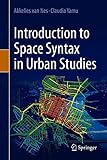Introduction to Space Syntax in Urban Studies [electronic resource] / by Akkelies van Nes, Claudia Yamu.
Tipo de material: TextoEditor: Cham : Springer International Publishing : Imprint: Springer, 2021Edición: 1st ed. 2021Descripción: XIX, 250 páginas196 ilustraciones, 149 ilustraciones in color. online resourceTipo de contenido:
TextoEditor: Cham : Springer International Publishing : Imprint: Springer, 2021Edición: 1st ed. 2021Descripción: XIX, 250 páginas196 ilustraciones, 149 ilustraciones in color. online resourceTipo de contenido: - texto
- computadora
- recurso en línea
- 9783030591403
- 304.2 23
Introduction: Urban Space as a Generator for Societal Processes -- Chapter 1: Introduction to the relevant spatial units -- Chapter 2: Spatial Relationships: Measuring integration and potential through movement.-Chapter 3: Orientation and Wayfinding: Measuring visibility -- Chapter 4: Private and Public space: Measuring the relation between buildings and streets -- Chapter 5: Linking Space Syntax to Socio-Economic Data -- Chapter 6: Space Syntax's Contribution to the Discourse in Urban Theory -- Chapter 7: Make the Urban Work: Application of Space Syntax in international research and practice -- Chapter 8: Get Started: How to undertake a Space Syntax analysis -- Chapter 9: Space Syntax Glossary and Useful Literature.
Open Access
This open access textbook is a comprehensive introduction to space syntax method and theory for graduate students and researchers. It provides a step-by-step approach for its application in urban planning and design. This textbook aims to increase the accessibility of the space syntax method for the first time to all graduate students and researchers who are dealing with the built environment, such as those in the field of architecture, urban design and planning, urban sociology, urban geography, archaeology, road engineering, and environmental psychology. Taking a didactical approach, the authors have structured each chapter to explain key concepts and show practical examples followed by underlying theory and provided exercises to facilitate learning in each chapter. The textbook gradually eases the reader into the fundamental concepts and leads them towards complex theories and applications. In summary, the general competencies gain after reading this book are: - to understand, explain, and discuss space syntax as a method and theory; - be capable of undertaking various space syntax analyses such as axial analysis, segment analysis, point depth analysis, or visibility analysis; - be able to apply space syntax for urban research and design practice; - be able to interpret and evaluate space syntax analysis results and embed these in a wider context; - be capable of producing new original work using space syntax. This holistic textbook functions as compulsory literature for spatial analysis courses where space syntax is part of the methods taught. Likewise, this space syntax book is useful for graduate students and researchers who want to do self-study. Furthermore, the book provides readers with the fundamental knowledge to understand and critically reflect on existing literature using space syntax.
No hay comentarios en este titulo.
